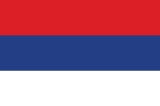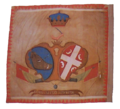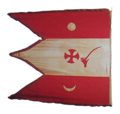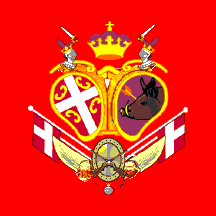
List of Serbian flags
Encyclopedia
This is a list of flags used in Serbia
. For more information about the national flag, visit the article Flag of Serbia
.




Serbia
Serbia , officially the Republic of Serbia , is a landlocked country located at the crossroads of Central and Southeast Europe, covering the southern part of the Carpathian basin and the central part of the Balkans...
. For more information about the national flag, visit the article Flag of Serbia
Flag of Serbia
The flag of Serbia is a tricolour consisting of three equal horizontal bands, red on the top, blue in the middle and white on the bottom. The same tricolour, in some variations, was the flag of Serbia throughout its history, and is the ethnic flag of the Serbian people.The state flag bears the...
.
National flag
| Flag | |Use | ||
|---|---|---|---|
| Flag | |Use | Flag of Vojvodina Flag of Vojvodina The flag of Vojvodina is based on the Flag of Serbia of which Vojvodina is a northern province. The flag consists of three horizontal strands of red, blue and white with the blue portion being significantly wider.... | Horitonzal tricolour of red, blue and white with larger blue portion. Three yellow stars representing the Bačka Backa Bačka is a geographical area within the Pannonian plain bordered by the river Danube to the west and south, and by the river Tisza to the east of which confluence is located near Titel... , Banat Banat The Banat is a geographical and historical region in Central Europe currently divided between three countries: the eastern part lies in western Romania , the western part in northeastern Serbia , and a small... and Srem Srem Śrem is a town on the Warta river in central Poland. It has been situated in the Greater Poland Voivodeship since 1999; from 1975 to 1998 it was part of the Poznań Voivodeship... regions. |
Standards
| Flag | |Use | President of Serbia President of Serbia The President of Serbia is the head of state of Serbia. Presently serving as the head of state is Boris Tadić. He was elected with a narrow majority of 50.31% in the 2008 Serbian presidential elections.-Authority, legal and constitutional rights:... | Square horizontal tricolour edged with greater arms. |
|---|---|---|---|
| 2004 – | Standard of the President President of the National Assembly of Serbia The President of the National Assembly of Serbia is the speaker of the parliament of Serbia... of the National Assembly of Serbia National Assembly of Serbia The National Assembly of Serbia is the unicameral parliament of Serbia. It is composed of 250 proportionally elected deputies elected in general elections by secret ballot, on 4 years term. The National Assembly elects the President of the National Assembly who presides over the sessions... |
Square horizontal tricolour with greater arms. |
Historical flags
| Flag | |Use | Serbia and Montenegro Serbia and Montenegro Serbia and Montenegro was a country in southeastern Europe, formed from two former republics of the Socialist Federal Republic of Yugoslavia : Serbia and Montenegro. Following the breakup of Yugoslavia, it was established in 1992 as a federation called the Federal Republic of Yugoslavia... | Horizontal tricolour of blue, white and red. |
|---|---|---|---|
| |
Republic of Serbia (federal) The Republic of Serbia was a federal unit of the Socialist Federal Republic of Yugoslavia from 1990 to 1992, the Federal Republic of Yugoslavia from 1992 to 2003 and the state union of Serbia and Montenegro between 2003 and 2006... |
Horizontal tricolour of red, blue and white. | |
 |
|
Socialist Federal Republic of Yugoslavia The Socialist Federal Republic of Yugoslavia was the Yugoslav state that existed from the abolition of the Yugoslav monarchy until it was dissolved in 1992 amid the Yugoslav Wars. It was a socialist state and a federation made up of six socialist republics: Bosnia and Herzegovina, Croatia,... |
Horizontal tricolour of blue, white and red with red star in the center. |
 |
|
Socialist Republic of Serbia Socialist Republic of Serbia was a socialist state that was a constituent country of the Socialist Federal Republic of Yugoslavia. It is a predecessor of modern day Serbia, which served as the biggest republic in the Yugoslav federation and held the largest population of all the Yugoslav... |
Horizontal tricolour of red, blue and white with red star Red star A red star, five-pointed and filled, is an important ideological and religious symbol which has been used for various purposes, such as: state emblems, flags, monuments, ornaments, and logos.- Symbol of communism :... in the center. |
 |
|
Kingdom of Yugoslavia The Kingdom of Yugoslavia was a state stretching from the Western Balkans to Central Europe which existed during the often-tumultuous interwar era of 1918–1941... |
Horizontal tricolour of blue, white and red. |
| |
Kingdom of Serbia The Kingdom of Serbia was created when Prince Milan Obrenović, ruler of the Principality of Serbia, was crowned King in 1882. The Principality of Serbia was ruled by the Karađorđevic dynasty from 1817 onwards . The Principality, suzerain to the Porte, had expelled all Ottoman troops by 1867, de... |
Horizontal tricolour of red, blue and white. | |
 |
|
|
Red bicephalic eagle Double-headed eagle The double-headed eagle is a common symbol in heraldry and vexillology. It is most commonly associated with the Byzantine Empire and the Holy Roman Empire. In Byzantine heraldry, the heads represent the dual sovereignty of the Emperor and/or dominance of the Byzantine Emperors over both East and... on yellow a field. |
 |
|
|
Horizontal bicolour of red and blue. |
Other flags




| Flag | |Use | Serbian Orthodox Church Serbian Orthodox Church The Serbian Orthodox Church is one of the autocephalous Orthodox Christian churches, ranking sixth in order of seniority after Constantinople, Alexandria, Antioch, Jerusalem, and Russia... | Horizontal tricolour with centered Serbian cross Serbian cross The Serbian Cross is a national symbol of Serbia, part of the Coat of Arms of Serbia, and the flag of Serbia. It is composed of a cross symbol with four C-shapes on each of its corners, in use as a national emblem since the 14th century.... . |
|---|---|---|---|
 |
|
Republika Srpska Republika Srpska is one of two main political entities of Bosnia and Herzegovina, the other being the Federation of Bosnia and Herzegovina... |
Horizontal tricolour of red, blue, and white. |
.svg.png) |
|
Republic of Serbian Krajina The Republic of Serbian Krajina was a self-proclaimed Serb entity within Croatia. Established in 1991, it was not recognized internationally. It formally existed from 1991 to 1995, having been initiated a year earlier via smaller separatist regions. The name Krajina means "frontier"... |
Horizontal tricolour of red, blue, and white. |
.svg.png) |
|
|
Horitonzal tricolur of red, light blue and white. |
 |
|
Socialist Republic of Montenegro Socialist Republic of Montenegro or SR Montenegro in shortened form, was a socialist state that was a constituent country in the former Socialist Federal Republic of Yugoslavia. It is a predecessor of the modern day Montenegro... |
Horizontal tricolor of red, blue and white with communist red star Red star A red star, five-pointed and filled, is an important ideological and religious symbol which has been used for various purposes, such as: state emblems, flags, monuments, ornaments, and logos.- Symbol of communism :... . |
.svg.png) |
|
Kingdom of Montenegro (1941-1944) The Kingdom of Montenegro or the Independent State of Montenegro existed from 1941 to 1943 as a puppet protectorate of Fascist Italy, a component of the envisioned Italian Empire... |
Horizontal tricolour of red, light blue and white. |
| |
|
Serbian tricolour with Serbian eagle Serbian eagle The double-headed eagle is a common symbol in Serbian heraldry and vexillology; the heads represent the dual sovereignty of the emperor and/or dominance of the Byzantine Emperors over both East and West.... and Serbian cross Serbian cross The Serbian Cross is a national symbol of Serbia, part of the Coat of Arms of Serbia, and the flag of Serbia. It is composed of a cross symbol with four C-shapes on each of its corners, in use as a national emblem since the 14th century.... as Coat of Arms. |
|
| |
|
As described in 1917 by Byron McCandless Byron McCandless Commodore Byron McCandless was a longtime U.S. Navy officer who was awarded the Navy Cross during World War I and the Legion of Merit during World War II. He was also prominent in the field of vexillology , and helped design two separate versions of the Flag of the President of the United States... , Gilbert Hovey Grosvenor Gilbert Hovey Grosvenor Gilbert Hovey Grosvenor , the father of photojournalism, was the first full-time editor of National Geographic Magazine, serving from 1899 to 1954. Grosvenor is credited with having built the magazine into the iconic publication that it is today... : Flags of the World. |
|
 |
|
|
National tricolor with Nicholas' insignia. |
.svg.png) |
|
|
Serb flag used throughout the existence of Montenegro to the present, recognized state flag until the one sanctioned by the 1905 Constitution. The Slavic tricolor versions proposed by Prince Danilo (based on the French liberal flag) were finally stabilized by adopting the Serbian tricolor in 1859. The flag was temporary used by Montenegrin institutions after multi-parliamentarism in 1991, until the old flag was restored in 1993. |
| |
|
Serbian tricolour with contemporary coat of arms and three six-pointed stars. | |
| |
|
Serbian tricolour according to the Sretenje Constitution. | |
| |
Second Serbian Uprising The Second Serbian Uprising was a second phase of the Serbian revolution against the Ottoman Empire, which erupted shortly after the re-annexation of the country to the Ottoman Empire, in 1813. The occupation was enforced following the defeat of the First Serbian Uprising , during which Serbia... |
A red cross on white background. Used at Takovo Takovo Takovo is a village in the municipality of Gornji Milanovac, Serbia. It has a population of about 500.The Second Serbian Uprising under the leadership of Miloš Obrenović started in this village.- External links :*... in 1815. |
|
| |
First Serbian Uprising The First Serbian Uprising was the first stage of the Serbian Revolution , the successful wars of independence that lasted for 9 years and approximately 9 months , during which Serbia perceived itself as an independent state for the first time after more than three centuries of Ottoman rule and... |
Red and white with cross, moon, sun and sword. | |
 |
|
First Serbian Uprising The First Serbian Uprising was the first stage of the Serbian Revolution , the successful wars of independence that lasted for 9 years and approximately 9 months , during which Serbia perceived itself as an independent state for the first time after more than three centuries of Ottoman rule and... |
War flag during the First Serbian Uprising. Red background with Serbian Coat of Arms (Serbian cross Serbian cross The Serbian Cross is a national symbol of Serbia, part of the Coat of Arms of Serbia, and the flag of Serbia. It is composed of a cross symbol with four C-shapes on each of its corners, in use as a national emblem since the 14th century.... ) and Triballi Coat of Arms. Serbian Crown Jewels Serbian Crown Jewels Serbia, like most European nations and former monarchies, has a history of crowns worn by its rulers. Serbia has had many rulers and royal families. As such Serbia has several distinct crowns followed by many jewels and other treasures of incredible wealth... on the top and two Voivode flags on the bottom. Adopted as the flag of Topola Topola Topola is a town and municipality situated in the Šumadija region of Serbia. It was the place where Karađorđe, a Serbian revolutionary, was chosen as the leader of the First Serbian Uprising against the Ottoman Empire in 1804. The local St... . |
 |
|
Serb clans Serb clans is a general term referring to what are known as plemena and bratstva , traditional geo-political units of the Western Balkans that now richly attest social anthropology and family history . The descendants of the clans are divided by regional and lately, national affiliation... |
Flags signifying a Serb clan, to differ from the authority of the Scander Metropolitan. Where created by ripping and resewing captured Ottoman flag Ottoman Flag The term Ottoman flag refers to any of the flags used by the ruling Sultans of the Ottoman Dynasty. Various flags were used within the Ottoman Empire during its existence, and the sultan also used different personal flags on different occasions of state... s. |
 |
|
|
Red cross on white field with red border. |
 |
|
Ivan I Crnojevic Ivan Crnojević was the medieval ruler of Zeta and first lord of the Principality of Montenegro from 1465 to 1490.-Reign:... |
White bicephalic eagle of the House of Nemanjić House of Nemanjic The Nemanjić was the most important dynasty of Serbia in the Middle Ages, and one of the most important in Southeastern Europe. The royal house produced eleven Serbian monarchs between 1166 and 1371. It's progenitor was Stephen Nemanja, who descended from a cadet line of the Vukanović dynasty... on red field. Used since Lord Ivan-bey the Black as a mark of succession to the Serbian Empire. |

